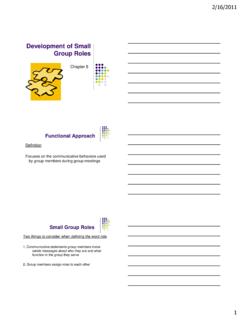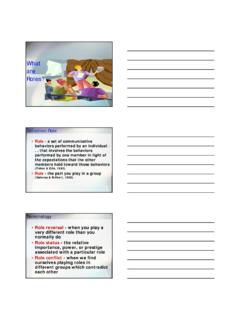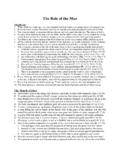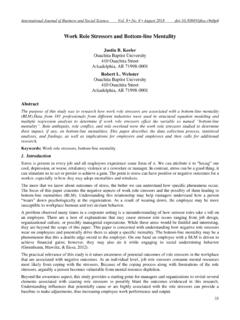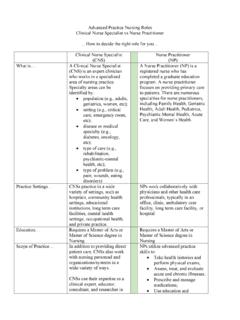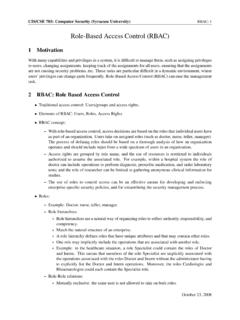Transcription of CHAPTER 1: The Preceptor Role in Health Systems …
1 1 CCHHAAPPTTEERR 11::TThhee PPrreecceeppttoorr RRoollee iinn HHeeaalltthh SSyysstteemmss MMaannaaggeemmeennttThroughout the nursing literature, the Preceptor is described as a nurse who teaches,supports, counsels, coaches, evaluates, serves as role model and aids in the socialization to a new assumption is that a consistent one-to-one relationship with a Preceptor provides the mosteffective mechanism for learning, whether the student is at the undergraduate, staff nurse, or graduatestudent level. The Preceptor guides the student into the real world of specialty practice, allowing thestudent to try new skills while gaining confidence and interest is the differentiation between Preceptor and the coach or mentor. A coach helpsan individual focus on a specific aspect of behavior, performance, or life. The focus is on learning andself-awareness. A coach helps the individual find their own best answers. A mentor looks after andguides the novice through a more personal, long-term relationship.
2 Typically the mentor helps to open doors for the individual, to assist in gaining entry into places and experiences they may nothave access to on their own. These important roles are discussed in more detail in CHAPTER literature is replete with issues, programs, and discussions related to clinical of the attention has been directed to clinical preceptors for new staff nurses. Less has beenwritten about graduate student issues, and fewer articles address issues of precepting graduate studentsmajoring in nursing administration or Health Systems most of the criteria for selection of successful preceptors applies across the boardto all settings. The Preceptor is expected to have the following characteristics: Desire to be a support/ teacher Competency in specialty area Effective interpersonal and communication skills Teaching skills Sensitivity to the learning needs of student Leadership skills Decision making and problem-solving skills Positive professional attitude Interest in professional growth Ability to provide feedback effectively to students and faculty.
3 Ability to provide accessibility to student for completion of projects/objectivesLikewise, the primary roles of the Preceptor are universal: Facilitator, helping student meet personal and course objectives Teacher, able to provide immediate answers to questions/ correct errors as they occur Role model, providing leadership and professional approach to practice. Nurturer, providing support and guidance through the difficult times. Evaluator, providing valuable formative and summative Resource, guiding student to appropriate material and human resources Monitor, sensitive to how student spends time without actually patrolling Socializer, assisting in the student s integration into the culture, politics, and rules ofthe organization/agency (adapted from Shah and Polifroni (1992)Some mention of differences in precepting in clinical versus administrative settings iswarranted. Students objectives in advanced practice nursing in clinical settings (nurse practitioner,clinical nurse specialist, nurse midwife, nurse anesthetist) tend to focus on attainment of a pre-determined skill set appropriate for one s area of specialty.)
4 These may range from pediatric skills tohome Health to critical care and the like. Usually there is one way to perform each procedure or skill:intubating a patient, performing a pelvic exam, conducting an exercise stress test. A simple checklistof whether the task/ competency was performed correctly or not, and the degree of independenceattained, are recorded and kept as a record for later validation of completing prerequisites forcertification. While subtle differences may be present across preceptors and agencies, the corecomponents of the skill are usually consistent. Clinical decision making is based on attention to thesubjective and objective data that guide the practitioner to the appropriate differential diagnoses andsubsequent plans of can argue that graduate students majoring in nursing administration experience a moreflexible approach to their practice experiences. When their nurse manager/ Preceptor is dealing withan agency problem, there is often not one tried and true method for dealing with it.
5 Each situationprovides its own constellation of cues that direct the best decision making approach. For studentscoming from a strong clinical background, this flexibility can become a frustrating experience, andone they need to be prepared for. Students earning masters degrees in nursing administration/ management usually come from avariety of past work experiences. While some students may have been a unit or project manager, morecommonly students are being exposed to the administrative role for the first time. In these times ofcost containment in Health care settings, managed care has eliminated many middle managementpositions along with assistant manager positions. Nurse managers frequently oversee several the student practicum may be the first opportunity to blend the theory attained from course workwith a close look at administrative issues in daily practice. At the same time, nurses are assumingleadership positions outside the traditional hospital or even outpatient care setting, in such areas asmanaged care and Health care organizations, long-term care facilities, and state and local governmentagencies.
6 Nurses are also in leadership roles in Health care informatics, and quality and outcomesmanagement. It is for these varied roles that this manual is cost-cutting scenario poses another problem, in that fewer managers are equipped with theexpert executive and leadership skills required to manage in these difficult times. This makes eachexperienced manager, like yourself, a rare commodity and a valuable potential Preceptor forgraduate students majoring in this PPrreecceeppttoorr CCoommppeetteenncciieessAt this point in time you may have been approached by nursing faculty to precept one of theirstudents or you may need to informally precept/mentor staff or colleagues. You may already be anexpert in precepting, and readily agree to participate. However, if you have had less experience in this3role, or are seeking to develop your personal skill set, then we suggest you use the following preceptorself assessment tool to guide you in this yourself for precepting includes comparing your own attributes with attributes ofeffective preceptors .
7 These attributes include personal ones, along with knowledge, skill and attitudeattributes. On the following pages you will find the effective Preceptor attributes presented in a self-assessment assessment format asks you how strongly you think you possess these attributes AND howfrequently you behave consistent with these attributes. You may find you have the knowledge, skilland disposition to display an attribute more frequently, but because of other priorities you do not havethe opportunity to use the attribute. It is possible that some of the features within your organizationalsetting present barriers to exhibiting some of the attributes. Therefore, the development plan portionof the assessment asks you to consider possible changes in your system or ways of working that wouldenhance your precepting attributes are culled from a variety of sources. They are presented below in the categoriesof person, knowledge, attitudes and skills. However, since the categories do not function separately inthe precepting process, these categories are not mutually exclusive.
8 Each of the attributes listed onthe following page can have a complete constellation of behaviors attached to them, as demonstratedin the table below for the Skill Attribute (#4): Teaching Skills . Teaching skills: Role models and acts as resource Articulates expectations clearly Assesses learning needs Collaborates with others to meet learning needs Involves self actively with student Thinks out loud to show student own thought processes Asks questions that stimulate thinking Recognizes learning opportunities Recognizes when student is having difficulty Reinforces learning Facilitates problem solving by the student Collaborates with the student to address issues Balances between offering independence and offering assistance Gives clear and useful feedbackInstructions for Preceptor Self-Assessment: Person, Knowledge, Attitudes, Skills1. Refer to the descriptions on the following rating scale, and mark each attribute with a number that best Summarize your highest and lowest attribute ratings in each On the Preceptor Development Plan, identify an action or two that you could take to strengthen your Consult the faculty member with whom you are working to assist you in accessing additional Scale: 1= Absent, never, definitely not me2= Rarely, at times this is me3= Sometimes this is me; inconsistent4= Often this is me5= This is who I am 1.
9 Person Attributes:- Warmth _____- Sense of humor_____- Maturity _____- Self-confidence _____- Charisma _____- Experience with success/ failure ____- Empathy _____- Trustworthiness, sincerity _____- Good example _____- Accessible to student _____- Flexible _____- Accountable _____2. Knowledge Attributes- Solid knowledge base in management _____- Knowledge regarding course objectives, content, learning resources, evaluation _____- Knowledge regarding student needs and objectives _____- Knowledge regarding interdisciplinary resources _____3. Attitude Attributes- Enthusiasm _____- Desire to teach _____- Willingness to take time with student _____- Respect for student_____- Supports student autonomy____- Concern for student and their progress _____- Nurturance, patience _____- Cultural awareness/sensitivity___- Acceptance of responsibilities of Preceptor role _____- Effective coping with work setting ambiguities _____- Comfort with Preceptor role ___- Value for professional growth__4.
10 Skill Attributes- Teaching skills _____- Coaching skills _____- Managerial skills _____- Corporate leadership skills ____- Problem solving/ decision making skills _____- Delegation skills _____- Conflict management skills _____- Team building skills _____- Communication skills _____5 Use the following Preceptor Development Plan to summarize your personal greatest greatest opportunities for do I plan to improve?What resources will I use?How will I fix the system to eliminate barriers to improvement?What time frames are appropriate for accomplishing these plans?The cultural diversity of the United States has caused many people to be exposed to behaviorsand beliefs that are unfamiliar and often uncomfortable for them. No where is this more evident thanin the multicultural Health care workforce. Nursing students are now being exposed to class topics oncultural competence related to patient care. However, little is being written about the challenges ofprecepting students who are of different cultures or ethnic groups.





